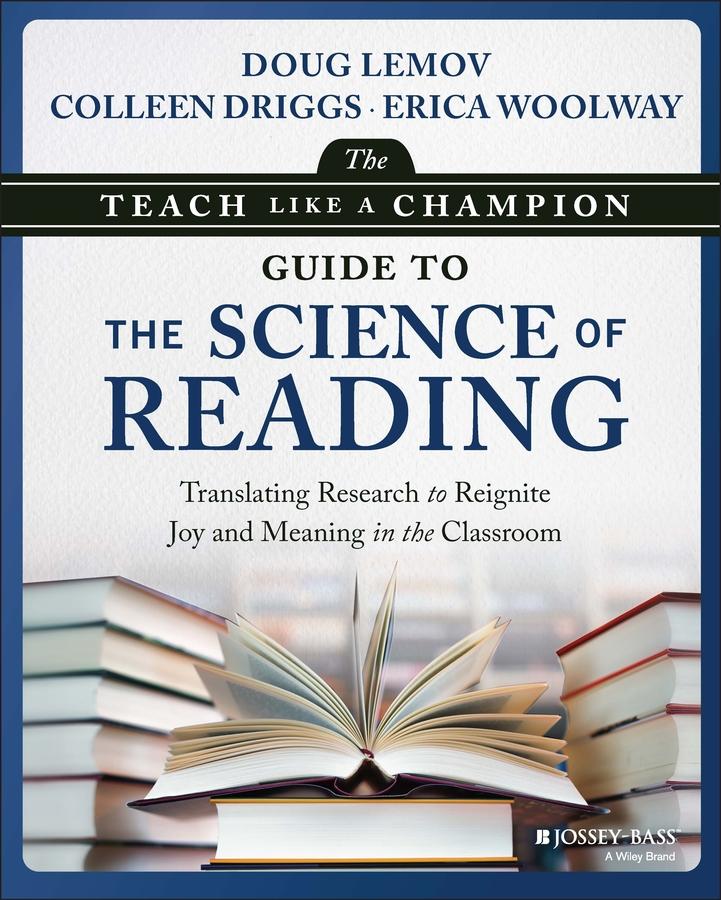"I love this book. Every teacher who asks their students to read will find it becomes the most worn on their shelf; it's a wellspring of clear explanation of the science of reading, and practical strategies for helping students become successful readers."
-DANIEL T. WILLINGHAM, Professor of Psychology at the University of Virginia and author of Why Don't Students Like School? , Outsmart Your Brain, and Raising Kids Who Read Learn to use the latest reading science to improve your literacy instruction In The Teach Like a Champion Guide to the Science of Reading, experienced literacy experts, educators, and authors, Doug Lemov, Colleen Driggs, and Erica Woolway deliver actionable guidance-grounded in seven evidence-based principles-that helps teachers use established science and research to ensure greater reading success once students have learned to decode. The book shares proven classroom instruction techniques that equip teachers, especially those in grades 3-12, to translate the latest reading science into teaching and curriculum design. It includes links to more than 50 video clips from the classroom that demonstrate the principles of the science of reading in action. The Teach Like a Champion Guide to the Science of Reading explains the central role of background knowledge in understanding text, the often-overlooked role of fluency in reading comprehension as well as the profound importance of managing and socializing attention in an age of technology. Perfect for teachers, literacy coaches, curriculum designers, and administrators aiming to foster rigorous literacy instruction in their classes and schools, this book is a powerful guide to helping students discover the joy of reading, helping them to become better, wiser, more engaged, and more motivated readers.
Inhaltsverzeichnis
About the Authors ix
Acknowledgments xi
How to Use This Book xiii
Introduction: "The Science of Reading": Shockwaves from a Podcast xvii
1 The Science of Reading in Seven Key Arguments 1
A Broad Base of Research 3
Seven Key Research- Backed Arguments About "Post- Phonics" Reading 4
"The Single Most Important Thing for Teachers to Know" 31
But Will Students Dislike It? 38
Notes 41
2 Attending to Attention 47
The Book Is Dying 49
We Wire How We Fire 55
Intentional Ways of Reading for Attention and Connection 61
High Text, Low Tech 71
Book- Driven Objectives 76
Principles of Reading in Action 79
Chapter Recap 82
Notes 82
3 Fluency and Ways of Reading 87
Orthographic Mapping 92
Balancing Three Ways of Reading 95
Teacher Read Aloud 97
Fase Reading 109
Accountable Independent Reading (AIR) 126
Chapter Recap 134
Notes 135
4 The Hidden Power of Background Knowledge 137
Research on Knowledge 139
We Know Knowledge Matters- Why Don't We Act That Way? 141
Performance on the New York State ELA End- of- Year State Test Grades 3-8 (2022-2023) 149
Embedded Nonfiction 151
Embellishments and Knowledge Feeding 163
Knowledge Organizers 168
Retrieval Practice 172
The Forgetting Curve 175
The Recursiveness of Knowledge: Putting It All Together 179
Chapter Recap 182
Notes 182
5 Vocabulary Reconsidered 185
Explicit Vocabulary Instruction 194
Implicit Vocabulary Instruction 205
The Vocabulary Case for Reading Aloud (and FASE) 210
Lesson Preparation 213
Recursiveness of Vocabulary 217
Chapter Recap 219
Notes 219
6 Using Writing to Develop Readers 221
"Write Down Some Ideas First" 225
Writing for Reading: Principles of Writing to Build Literacy 231
Putting It All Together 271
Chapter Recap 273
Notes 274
7 The Power of the Book 277
Why Have All the Books Gone? 282
Stories are Cognitively Privileged 285
The Medium Is the Message 290
Books Provide Valuable Cultural Capital 291
All Books Are Equal, But Some Books Are More Equal Than Others 294
Getting Them to Read 299
Chapter Recap 302
Notes 304
8 Close Reading 307
Jen Brimming's Close Reading of Lord of the Flies 309
Short Bursts and Opportunities to Encode 319
Selecting Complex Texts for Close Reading 322
Selecting Textual Excerpts 325
The Critical Importance of Establishing Meaning 328
Attentionally Privileged Environments 335
More Examples of Effective Close Reading Questions 338
Knowledge, Disambiguation, and Close Reading 348
Close Reading in the Context of a Lesson 350
Chapter Recap 359
Notes 360
Appendix A: Full Sample Lesson, Seventh Grade 363
Appendix B: Full Sample Lesson, Ninth Grade 375
Appendix C: Decoding Tips 393
Appendix D: Reading Reconsidered Curriculum: The Giver Fluency Practice: Sample Materials 397
Appendix E: Materials for Knowledge Building: Embedded Texts 403
Index 419













